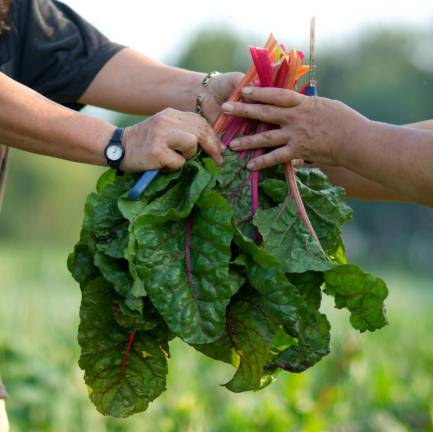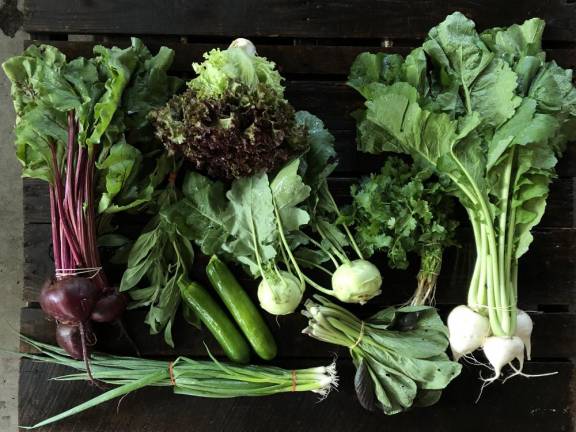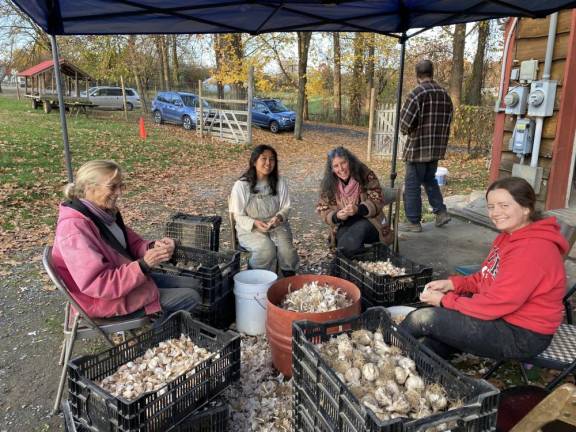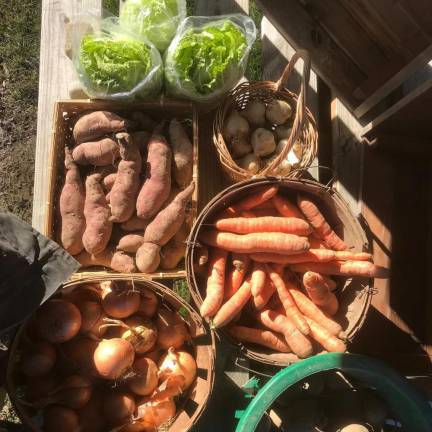‘A Boomer thing?’: The uncertain future of the CSA
After a pandemic-fueled surge, will the idealistic model of community supported agriculture survive the Age of Convenience?




As a CSA farmer of three seasons, I have personally experienced the joys of connecting with the people for whom we grow food. Sharing the fruit of our labor directly with members — from toddlers to elderly parents whose adult children help them pick out veggies — makes food pick-up days feel more like community gatherings than monetary transactions.
Community Supported Agriculture is a model of direct marketing brought by European farmers to the Northeast in the 1980s, cutting out the middleman between farmer and eater. Typically, members pay up front in the spring for a “share,” usually a weekly box of farm produce, providing the farmer with cash when it’s most needed and distributing the risks, rewards and sometimes the work of growing food over the course of a season.
But despite the community-building power of CSAs, which enjoyed a pandemic-fueled surge as the global food supply faltered, many farmers report that membership is once again on the decline. It has been, in fact, for over a decade. From 2012 to 2020, the number of CSAs tumbled more than 40 percent, according to the United States Department of Agriculture census, from 12,617 to 7,244 farms selling direct to consumers. Though the Northeast remains a stronghold of the model, even here the reawakened interest in slow food that the pandemic brought about is looking to many farmers like a nostalgic blip in the larger scheme of things. In today’s highly individualistic society, relying on community can be a big ask.
After attending the Hudson Valley CSA Coalition’s fourth annual summit in February, I got on the phone with farmers in the black dirt region to see what’s going on with their CSAs.
The pros: spring cash influx and ‘a face to the food’
Historically, farmers would take out loans before the start of the growing season to buy seed, equipment and make repairs. The CSA model grew out of a want to rely on community members instead of loans for that financial jumpstart. For farmers like John Krueger at Circle Brook Farm in Andover, NJ, especially during his first few years of farming, the financial leeway that the CSA model offered was vital.
Although the cash influx is less critical now that he’s established, “upfront money is still very helpful,” he said. “It’s just a foundation. Even if I’m making a bit [of money] on the CSA, it’s okay because it supports the rest of the farm operation.” A diversified vegetable farm growing on about 60 acres, Krueger sells his veggies wholesale, in three different markets. He’s “happy to let people get a good deal with the CSA, and for them to be able to afford organic food,” he said. Krueger runs volunteer days throughout the season. Especially for urban members from Jersey City, Hoboken, and Staten Island, on-farm events are “important for them to understand where their food is coming from,” he said.
Circle Brook Farm CSA members volunteer when peas, beans, garlic, onions and winter squash are ready for harvest, and then join in for a farm tour.
Farmers Mike Baki and Judy von Handorf of Genesis Farm in Blairstown, NJ, one of the oldest CSA farms in the region, “hold pretty much to the original CSA model,” said Baki. One of the greatest values of that model is that customers “put a face to the vegetables. Walking down in the fields and walking in U-Pick, they have the opportunity to make strong connections with the land.”
“We try to keep it active as much as we can, and a lot of people chip in to do these things,” said von Handorf. The nonprofit farm fosters community involvement through myriad events including open-house days with tours, children’s activities, potlucks, open mics, seed saving activities, mushroom workshops, student visits from a nearby charter school. The farm relies upon “tremendous community help,” said Baki. CSA members even helped build the barn.
The farmers interviewed have all enjoyed high membership retention rates over the years, which brings with it the unique job satisfaction of watching families grow up on their food.
Kasha Bialas of Bialas Farms in New Hampton, NY, a 55-acre family farm since 1939, is now feeding some of the children of her original CSA members. She often hears things from her regulars like, “after one year of black dirt carrots, they can’t eat carrots from ShopRite anymore. That’s what you want,” she said. An avid cook, Bialas sends recipes and a newsletter home with each share, because members “like to be given resources all in one place,” she said.
“Nurturing customer relationships is one of the strong suits” of the CSA model, said Bialas, who makes sure to ask questions, listen, and remember whose child loves carrots. In addition to her farm stand and on-farm CSA pickup, she also hosts a plant sale and an open house with artisans’ sales.
Knitting the community and farm together is the eternal appeal of the CSA. Raphael Cox, farmer at the new-this-year Garden of Edenville in Edenville, NY, put out a call for CSA members ($100) in February. “The goal is that it’s not only community supported,” said Cox, “but to create a closer knit community, so we’re going to incorporate edible landscaping classes, workshops on how we prep the fields, have parties whether it’s canning or a cover crop dance party.” As of mid-March, one member had signed up. “So far everything has been out of pocket and a labor of love,” said Cox, who also works full-time growing cannabis for Green Thumb in Warwick.
The competition: fast groceries
However, as families move away, parents become empty-nesters and elderly customers reach a point where they’re not cooking as much, farmers from longstanding CSA farms are finding it increasingly difficult to bring in new members. Many community farms used to have waiting lists to become CSA members. Now, interest in membership is declining, and farmers are scrambling for new ways to advertise their CSAs to a younger clientele through platforms like Facebook and Instagram (where they are up against farms that tend to look perfect and clean, unblemished by realities like droughts, floods, pests, labor shortages and plant disease).
Krueger, of Circle Brook Farm, hypothesized that the CSA model might prove to be “a Boomer thing,” while society at large turns, in this rushed world, to convenience. Young professionals grinding away at nine-to-five desk jobs might simply feel that they do not have the time to cook. And why should they, with apps like DoorDash, Hello Fresh, and Instacart ready to deliver customized groceries or prepared food right to their doorstep? Then there’s the proliferation of delivery services that claim to rescue “misfit” or “ugly” produce, appealing to a sense of virtue even while reinstalling a middleman between farmer and customer.
Agriculture has never been a cushy line of work, but this is a particularly tough time for the small-scale farmer. At the Hudson Valley CSA Summit, I learned that many CSA farmers are struggling to provide basic livable wages for workers, not to mention health insurance, retirement and housing options. While offering employees financial transparency and all-access to leftover vegetables does attract young workers who find their calling in farming, there’s no getting around the relentless squeeze of small farmers in competition with industrial giants.
“Sometimes I think we’re the last generation that will be able to farm at a family scale,” said Kristin Kimball, author of The Dirty Life, who with her husband farms Essex Farm, a groundbreaking farm near Lake Champlain that offers 300 families a whole-diet, year-round, free choice CSA. She was speaking last winter at a “Save Winter” conference on sustainability in Lake Placid, NY. “I love what we do with my whole being,” she said. “[But] it hasn’t gotten easier in 20 years.”
Many small farms have had no choice but to shutter their CSAs or even the entire farm operation, though not for lack of an abundance of good food. Fledging Crow Vegetables in the Adirondack’s Keesville, an organic farm that offered dozens of CSA shares and sold at markets from Brooklyn to Lake Placid, declared bankruptcy last year after 15 years of farming, citing debts of $450,000. The farm had gotten back on its feet thanks to a pandemic-fueled boom the farmer called “miraculous,” but that rally gave way to the prevailing trend: a steady decline in business.
“I’m still incredibly enthusiastic about growing food for the local community,” farmer Ian Ater told the Adirondack Daily Enterprise. “How that looks is a question today.”
In a group discussion at the Hudson Valley CSA Summit, a roomful of CSA farmers was asked how long we had been working at our farms. Of about 40 farmers, only two had worked a decade or more on their farm, while most of us in the room had worked on their farm three years or less. Given the seasonality of farming, the need for long-term experimentation and understanding of farmland throughout the seasons, the high rate of turnover is not promising.
A two-way street
The CSA membership is a commitment. Having to pay for a full season of produce upfront has always been a hurdle for some consumers, while the obligation of a weekly pickup can be a challenge for single folks, would-be vacationers or those with irregular work schedules.
That’s why Krueger and his team make the effort to deliver an overwhelming majority of farm shares either directly to people’s doors, or to pick-up locations like a church or synagogue where volunteers help distribute the food. His team sometimes drives up to an hour and a half to drop off food. But even after these adaptations to customers’ preferences, there are still hurdles to drumming up membership.
Krueger encourages customers to preserve extra food, especially if there’s some bounty of, say, two pounds of green beans per CSA member. “It’s easy to freeze!” has become something of a mantra. “If members feel they cannot eat it all, they might drop out,” Krueger knows. “Not even for monetary reason, but because they feel bad about food going to waste.”
People “want just enough, and not an overwhelming amount,” adds Bialas. “Overwhelming people is what stops people from buying. They do not want to waste or get something [they] can’t handle.” For this reason, many CSA farmers offer smaller share options and collaborate with nonprofits to donate extra food.
Baki, from Genesis Farm, lets prospective members know that just like any other relationship, this one is a two-way street. “What we are selling is work. Do you like to cook?,” he sometimes asks new CSA members. “Because this is what it’s about, if it’s gonna work for you.”
The Hudson Valley CSA Summit’s closing presentation, Fostering Community Spaces, highlighted that CSA farms are a type of “third space,” a public place where community members freely relate to each other and generosity overrides monetary transaction. Unlike other third spaces like public parks, where passive participation is the norm, CSA farms provide community members the opportunity to interact directly with the land – and in the process, to begin to mend our collective broken relationship with nature. That’s a heap more than can fit in a FreshDirect box.